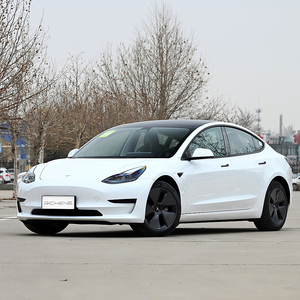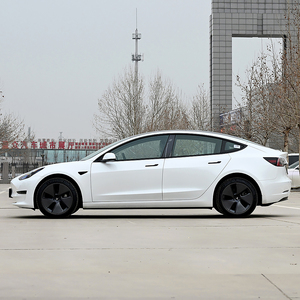Types of Electric Vehicles
The electric vehicle market offers various options to match different driving needs and environmental priorities. Understanding the key differences between types helps in making an informed decision.
Battery Electric Vehicles (BEVs)
BEVs operate exclusively on electricity stored in battery packs that power electric motors. With zero tailpipe emissions, they represent the purest form of electric transportation.
Key Features: 100% electric, zero emissions, regenerative braking, typically 150-400 mile range
Plug-in Hybrid Electric Vehicles (PHEVs)
PHEVs combine an electric motor with a conventional gasoline engine, offering electric-only operation for shorter trips while maintaining long-distance capability with the gasoline engine.
Key Features: Dual power sources, 20-50 mile electric range, reduced emissions, flexibility
Hybrid Electric Vehicles (HEVs)
HEVs utilize both electric motors and gasoline engines working in tandem. Unlike PHEVs, they cannot be plugged in and rely on regenerative braking and the engine to charge their smaller batteries.
Key Features: Self-charging, improved fuel efficiency, lower emissions than conventional vehicles
Solar-Powered Electric Vehicles
These innovative vehicles supplement their energy needs with solar panels integrated into the vehicle's surface, converting sunlight directly into electricity.
Key Features: Solar panel integration, reduced charging needs, environmentally friendly, emerging technology
Expert Tip: BEVs offer the simplest ownership experience with fewer moving parts and maintenance requirements, while PHEVs provide flexibility for those concerned about range limitations. Consider your typical driving patterns when choosing between them.
| Vehicle Type | Power Source | Electric Range | Emissions Level | Best For |
|---|---|---|---|---|
| Battery Electric (BEV) | 100% Electric | 150-400+ miles | Zero tailpipe emissions | Daily commuting, urban driving, environmentally conscious |
| Plug-in Hybrid (PHEV) | Electric + Gasoline | 20-50 miles electric | Low emissions (when using electric) | Mixed driving needs, limited charging access |
| Hybrid (HEV) | Primarily Gasoline | 1-3 miles electric assist | Reduced emissions | Fuel efficiency with no charging required |
| Solar-Powered EV | Solar + Battery Electric | Varies by model | Zero tailpipe emissions | Sunny climates, tech enthusiasts |
Electric Range Comparison
Specifications and Maintenance of Electric Vehicles
Maintaining an electric vehicle differs significantly from conventional vehicles. Understanding these key maintenance areas ensures optimal performance and longevity of your EV investment.
Battery Health
The battery is the heart of your electric vehicle, determining range and performance. Optimal maintenance includes:
- Keep state-of-charge between 20-80% for daily use
- Avoid extreme temperature exposure when possible
- Install manufacturer software updates promptly
- Monitor degradation using vehicle diagnostics
Tire Maintenance
EVs deliver instant torque and are typically heavier than conventional vehicles, affecting tire wear:
- Check pressure weekly (EVs often require higher PSI)
- Rotate tires every 6,000-8,000 miles
- Consider low rolling resistance options for efficiency
- Monitor tread wear patterns for alignment issues
Braking System
Regenerative braking reduces wear on physical brakes but requires different attention:
- Inspect brake pads annually despite reduced wear
- Replace brake fluid every 2-3 years (moisture accumulation)
- Occasionally use friction brakes to prevent rotor rusting
- Check regenerative braking efficiency in vehicle diagnostics
Software Updates
EVs rely heavily on software for optimal performance:
- Enable automatic updates when available
- Check manufacturer apps/websites monthly
- Updates may improve range, charging, and features
- Some critical updates require dealer installation
Cooling System
Temperature management is critical for battery protection:
- Inspect coolant levels quarterly
- Replace coolant per manufacturer schedule
- Check for leaks around battery compartment
- Ensure cooling vents remain unobstructed
Maintenance Advantage: Electric vehicles typically require significantly less maintenance than conventional vehicles - no oil changes, fewer brake replacements, and fewer moving parts. This translates to lower lifetime maintenance costs and fewer service visits.
| Maintenance Item | Frequency | Importance | DIY Difficulty |
|---|---|---|---|
| Battery Health Check | Quarterly | Critical | Low (using vehicle diagnostics) |
| Tire Rotation | Every 6,000-8,000 miles | High | Medium |
| Brake Fluid Replacement | Every 2-3 years | Medium | Medium |
| Software Updates | As available | High | Low |
| Coolant System Check | Annually | High | Medium |
| Cabin Air Filter | Every 15,000 miles | Low | Low |
How to Choose Electric Vehicles
With the growing number of electric vehicle options available, selecting the right EV requires careful consideration of several key factors tailored to your specific needs and circumstances.
Range Considerations
Electric range is one of the most critical factors when choosing an EV:
- Modern long-range EVs offer 250-400+ miles per charge
- Analyze your daily driving needs (commuting distance)
- Consider occasional longer trips and charging availability
- Remember that range decreases in cold weather (20-30%)
Charging Infrastructure
Accessible charging options significantly impact your EV experience:
- Home charging: Level 1 (120V standard outlet) or Level 2 (240V)
- Workplace charging availability
- Public charging networks along frequent routes
- Fast charging capability for longer trips (50-350 kW)
Total Cost of Ownership
EVs often cost more upfront but save money long-term:
- Purchase price after available tax incentives
- Electricity costs vs. gasoline (typically 60-75% savings)
- Reduced maintenance expenses (no oil changes, fewer brake repairs)
- Potential insurance differences
Environmental Impact
Environmental benefits vary based on several factors:
- Zero tailpipe emissions improve local air quality
- Carbon footprint depends on electricity generation source
- Battery production environmental impact (improving with technology)
- Vehicle manufacturing and materials sustainability
Performance Characteristics
EVs offer unique driving experiences:
- Instant torque provides rapid acceleration
- Lower center of gravity improves handling
- Regenerative braking offers one-pedal driving capability
- Quieter operation reduces noise pollution
Important Consideration: When evaluating range needs, don't simply consider your daily commute. Account for occasional longer trips, detours, climate impacts on battery efficiency, and the potential need to reach multiple charging stations if one is unavailable.
| Selection Factor | Key Questions to Ask | Impact on Ownership |
|---|---|---|
| Range | What is my daily commute? How often do I take longer trips? | Determines charging frequency and travel flexibility |
| Charging | Can I install home charging? Are there chargers near work? | Affects convenience and potential charging costs |
| Cost | What incentives am I eligible for? What are my electricity rates? | Influences total ownership expenses over vehicle lifetime |
| Environmental Impact | What is my local electricity generation mix? How important is emissions reduction? | Determines actual environmental benefit of EV ownership |
| Performance | Do I value acceleration? Is regenerative braking important to me? | Affects driving experience and satisfaction |
DIY and Replacement Guide for Electric Vehicles
While electric vehicles have fewer mechanical components than conventional vehicles, there are still maintenance and replacement tasks that can be performed by owners with the right knowledge and precautions.
Safety First
Electric vehicles contain high-voltage components that require special handling:
- Always consult the owner's manual before attempting any work
- Wear insulated gloves when working near electrical components
- Follow proper battery disconnect procedures
- Work in a dry, well-ventilated area
Gather Necessary Tools
Proper tools ensure safe and effective maintenance:
- Insulated tools rated for electrical work
- Digital multimeter for electrical testing
- Torque wrench for precise tightening
- Vehicle-specific diagnostic tools or apps
Consult Service Manual
EV-specific documentation is crucial for safe work:
- Obtain the official service manual for your specific model
- Review wiring diagrams before electrical work
- Follow manufacturer-recommended procedures exactly
- Note torque specifications for all fasteners
Prepare Work Area
A properly prepared workspace increases safety:
- Choose a level, dry surface away from water sources
- Ensure adequate lighting for detailed work
- Keep fire extinguisher rated for electrical fires nearby
- Remove metal jewelry before working
High-Voltage Safety
Extra precautions for high-voltage components:
- Never touch orange-colored high-voltage cables
- Wait at least 10 minutes after disconnecting the battery
- Use a voltmeter to verify components are de-energized
- When in doubt, consult a certified EV technician
Safety Warning: Never attempt DIY repairs on high-voltage components (battery pack, inverter, drive motors) unless you are professionally trained. Improper handling can result in serious injury or death.
| DIY-Friendly Tasks | Professional-Only Tasks | Tools Required | Safety Considerations |
|---|---|---|---|
| Cabin air filter replacement | High-voltage battery service | Basic hand tools | Low risk |
| Wiper blade replacement | Drive motor repairs | None | Low risk |
| Tire rotation | Inverter or converter service | Jack, jack stands, torque wrench | Medium risk (crushing hazard) |
| 12V battery replacement | High-voltage cable repair | Insulated tools, gloves | Medium risk (electrical) |
| Brake fluid check/top-off | Thermal management system repair | Specific brake fluid, gloves | Medium risk (chemical) |
Maintenance Tip: Many EVs have excellent self-diagnostic capabilities through their infotainment systems or companion smartphone apps. Regularly check these diagnostics to identify issues before they become serious problems.
Frequently Asked Questions
Electric vehicles offer numerous advantages over conventional vehicles:
- Environmental Benefits: Zero tailpipe emissions, reducing air pollution and greenhouse gases
- Lower Operating Costs: Electricity is significantly cheaper than gasoline or diesel (typically 60-75% less per mile)
- Reduced Maintenance: Fewer moving parts means less maintenance (no oil changes, fewer brake replacements)
- Performance: Instant torque provides responsive acceleration and smooth driving experience
- Quieter Operation: Electric motors run silently, reducing noise pollution
- Energy Efficiency: EVs convert approximately 60% of electrical energy to power at the wheels, compared to 20% for gas vehicles
Electric vehicles can be charged through various methods:
- Home Charging (Level 1): Using a standard 120V household outlet, providing 3-5 miles of range per hour of charging
- Home Charging (Level 2): Using a 240V outlet or installed charging station, providing 15-30 miles of range per hour
- Public Charging Stations: Network of Level 2 chargers in parking lots, shopping centers, and workplaces
- DC Fast Charging: High-powered stations providing 100-300 miles of range in 30-60 minutes, typically located along highways
- Workplace Charging: Many employers offer charging stations as an employee benefit
Most EV owners (80%+) do the majority of their charging at home overnight, starting each day with a full charge.
The fundamental differences between BEVs and PHEVs include:
- Power Source: BEVs run exclusively on electricity stored in batteries, while PHEVs combine an electric motor with a conventional gasoline engine
- Range: BEVs typically offer 150-400+ miles of electric range, while PHEVs provide 20-50 miles of electric range before switching to gasoline
- Fueling/Charging: BEVs can only be recharged with electricity, while PHEVs can be both recharged with electricity and refueled with gasoline
- Emissions: BEVs produce zero tailpipe emissions, while PHEVs produce zero emissions when running on electricity but generate emissions when using the gasoline engine
- Complexity: BEVs have simpler drivetrains with fewer moving parts, while PHEVs have more complex systems managing both electric and gasoline power sources
Charging time varies significantly based on several factors:
- Charger Type:
- Level 1 (120V): 8-20 hours for a full charge
- Level 2 (240V): 3-8 hours for a full charge
- DC Fast Charging: 20-60 minutes to 80% charge
- Battery Size: Larger capacity batteries take longer to charge
- Starting Charge Level: Charging from 20% to 80% is typically faster than the final 20%
- Vehicle's Maximum Charging Rate: Different EV models accept different charging speeds
- Temperature: Extreme cold or heat can slow charging rates
Most EV owners rarely need a complete 0-100% charge in a single session, as they typically top up regularly and rarely deplete the battery completely.
Modern electric vehicles are increasingly well-suited for long-distance travel:
- Extended Range: Many newer EVs offer 250-400+ miles of range per charge
- Growing Charging Network: Fast-charging infrastructure continues to expand along major highways and travel corridors
- Faster Charging Speeds: Latest EVs can add 150-200 miles of range in just 15-20 minutes at high-powered chargers
- Trip Planning Tools: Most EVs include built-in navigation that automatically plans charging stops
- Smartphone Apps: Multiple apps help locate charging stations and plan efficient routes
While long-distance EV travel requires more planning than with gasoline vehicles, many drivers find the brief charging stops beneficial for rest breaks. The situation continues to improve rapidly as charging infrastructure expands.









































































































































































































































































 浙公网安备 33010002000092号
浙公网安备 33010002000092号 浙B2-20120091-4
浙B2-20120091-4